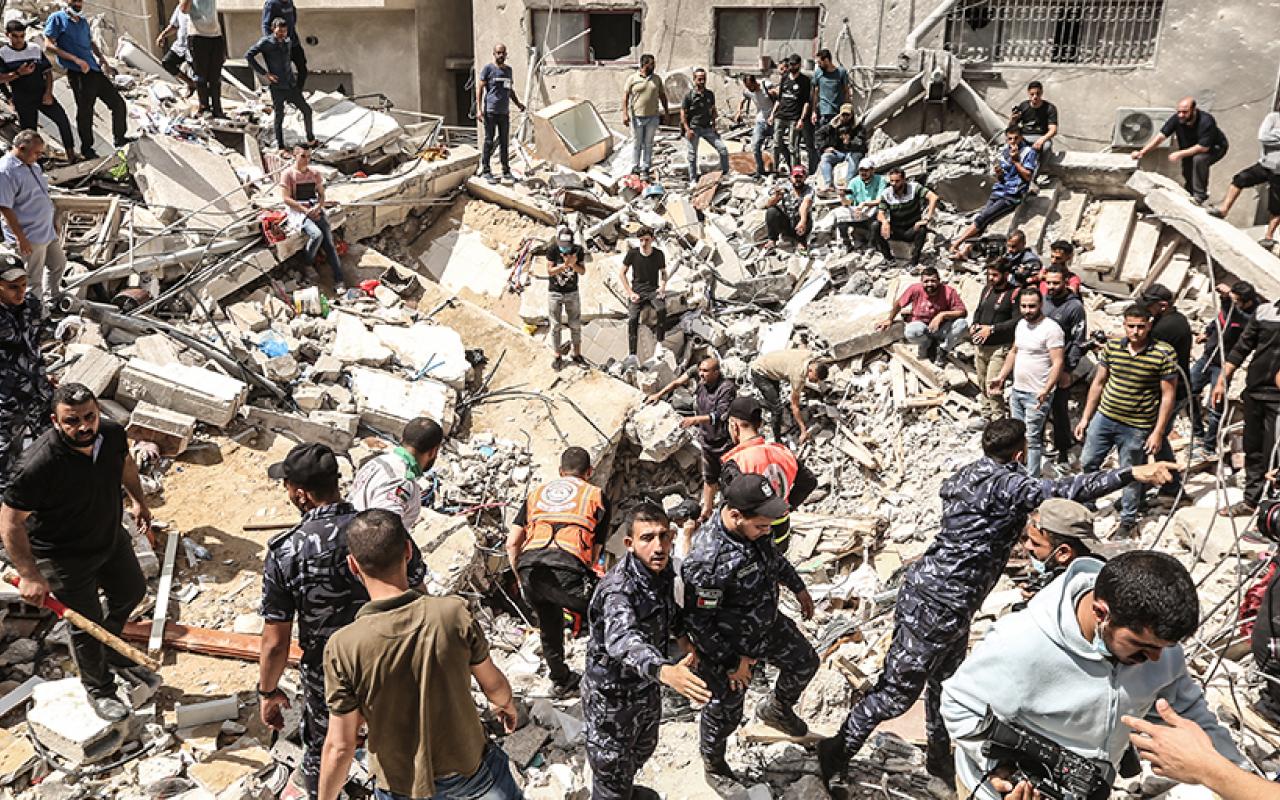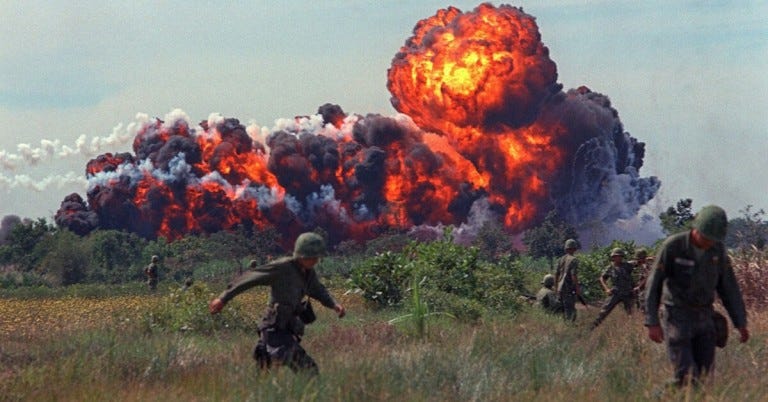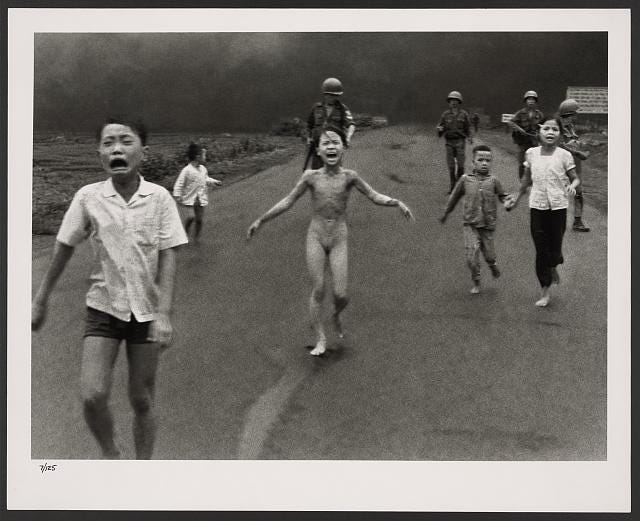The Second Casualty
"Nothing seems to have changed in a century and a half. Humans are still killing other humans because of their differing gods or how they look, or the things they believe... and the children still fall first."

"In war, truth is the first casualty.” - Aeschylus, Greek Dramatist
One morning in the spring of my twentieth year, I awoke in a tent on the east bank of the Potomac River. The sun had not yet transited the horizon but there was enough light for people to begin moving and talking and cooking. Tens of thousands of Vietnam War protestors had gathered at Potomac Park, camping just a short walk from the Lincoln Memorial. We had been drawn to Washington, D.C. to participate in a May Day March down Pennsylvania Avenue to the White House, hoping our discontent and disgust with the Southeast Asian conflict could be expressed in mass numbers, and maybe even influence the President.
I had hitchhiked down from Michigan and had arrived late the previous night and struggled to set up my tent. When I crawled out between the unzipped flaps, an older man with gray in his long beard, appeared to have been waiting for me. A stack of poster boards were loaded into his arms, and each was attached to a wooden stick. I assumed he was offering them to marchers to mark up with their own protest messages.
“Hey kid,” he said. “Can you carry one of these in the march?”
“Yeah, sure. Be glad to.”
“Great thanks. Been having troubling giving them away.”
I took the wooden stick and saw the blank white poster board and then turned it over as he walked down through the sleeping bags and U-Haul trucks and VW vans. There was a photograph, blown up to fill the board, and the image was horrifying. I called after him.
“Hey, mister, I can’t carry this. Come back and get it. Let someone else.”
All I saw was his hand raised in the air and waving, a gesture he performed without turning back in my direction.

After I dropped the poster, the image I confronted was the result of napalm, a jellied gas that burned at as much as 2000 degrees Fahrenheit. American aircraft had been dropping the weapon on jungles and villages and humans in Vietnam, and many of them were children. A single napalm bomb was capable of completely incinerating 2500 square yards, and anything within that perimeter, including people. The picture laying at my feet was of four victims, children burned beyond what was recognizably human, their limbs drawn and gnarled, stretches of bone exposed, fingers and toes missing. The efficient killing was made possible by Dow Chemical of Michigan and was part of the reason 84,000 estimated children were killed in the conflict.

Children always die in war, of course, victims of the geography into which they were born. Their loss ought to subtract more from our humanity but we grow inured to the reductions, as if it were an unavoidable fact of living in this world. A few shocking photographs, seconds of video, and we are compelled to turn away and try not to think about what is unfolding in our sometimes hideous existence. We cannot often see these tragedies. Editors protect us from the imagery and facts. Death and war get sanitized.
In the current conflict between Israel and Hamas, however, the Palestinian Ministry of Health reports 3900 children dead and 7695 injured. These are numbers verified by admissions to hospitals in the Gaza strip. Another 1200 are reported missing under the rubble of bombed out structures, which has also been the primary cause of the death of children. The charity, Save the Children, says its numbers show that about 400 children are killed or injured every day the bombing continues.
When Hamas attacked Israel on Oct. 7, it is estimated there were more than 1400 dead, a number which included 30 Israeli children. Israel says there are still at least 20 Israeli children being held hostage in Gaza. The slaughter of innocents and the truth was sufficiently horrifying without subsequent distortions from political leaders, who passed on unverified information. Even the American President spoke of the beheadings of 40 Israeli babies, a story extrapolated from a field reporter who said IDF soldiers had spoken of babies being killed and beheaded. No evidence has ever been produced to indicate such violence happened, but it was an early outrage that ended many international sentiments for Hamas, brutal killers and rapists, seemingly lacking all humanity. But the fallacy of the beheaded babies helping nothing. Disinformation can be as deadly as a gun.
Estimates from the U.N. and authorities in Gaza say that about 40 percent of the dead are under the age of 18. The U.N. and the World Health Organization report women, children, and newborn babies represent 67 percent of all Gazan casualties in the war. Those are only numbers, though, not the names of toddlers or mothers or sisters or wives or grandmothers. Hamas is said to have kidnapped 240 people from Israel and taken them back to hidden captivity while families suffer endless anxiety and the IDF continues to focus on the terrorists’ outposts.
The history of the clash of religions and cultures in Israel has been deconstructed by thousands of writers and historians. Treaties and accords and dreams of two-state solutions continue to get side-tracked by the realities of everyday life, which includes terrorism and intergenerational anger. Palestinians deal with about 50 permanent and manned checkpoints, two international crossings to Egypt and Jordan, and more than 600 unmanned barriers as they try to move from Gaza and the West Bank to other locales for work and familial interactions. The impact on how they live and the simple logistical challenges is difficult to describe or understand for outsiders with no sense of what happens in the occupied territories, nor is it possible to relate to Israelis’ fears of terrorism or attacks by Palestinians. The anger, though, and its causes, are clear.
The mantra repeated by the U.S. and its allies, though, “Israel has a right to defend itself,” is beginning to be shouted down by critics claiming the IDF’s response to Hamas has been far too disproportionate. The IDF has bombed six refugee camps, the latest being Jabalia, which took 195 lives. Israeli military spokesmen said Hamas maintains tunnels under the camps and they must be destroyed. The Office of the U.N. Human Rights Commissioner Volker Turk recently was quoted as saying the overwhelmingly disproportionate response could amount to war crimes. What is even more confounding is that leadership on both sides of the conflict lacks respect from their citizenry. Palestinians disdain Hamas as much as many Israelis despise Prime Minister Bibi Netanyahu, a man as divisive as Donald Trump.
The present accusation against Netanyahu being heard in many locations around the world is that he is trying to affect a genocide of Palestinians. If the bombing continues to be overwhelmingly destructive, there will be nothing to rebuild, much less the will to try. Gaza residents who survive are likely to leave the hellscape and may create a new diaspora, spread across the Mideast and Europe without a homeland, their numbers dramatically reduced by the IDF’s assault on their narrow strip of land. Israel may also be creating a new generation of terrorists, young fighters who join Hamas or Hezbollah with no intentions or plans for their lives other than vengeance.
We are not strangers in this country to the concept of genocide, and used it extensively to facilitate expansion westward. When the various American Indian tribes living on the Central Plains refused to be constrained by the boundaries of a reservation, Gen. William Tecumseh Sherman began executing tactics to end their existence. Orders were given to Lt. Col. George Armstrong Custer to patrol the plains and eliminate tribes that were still hunting buffalo and visiting depredations upon settlers and railroad builders. Custer, always eager to kill for glory, was excited about his new orders and began his battle march in the winter when he knew the Indians would be camped, waiting for warmer weather.
A preview of the slaughters to be perpetrated by Custer had been seen at Sand Creek in Southeastern Colorado four years previous. A U.S. Cavalry detachment from Denver rode out to a peaceful encampment of about 750 Cheyenne and Arapaho. One of the chiefs, Black Kettle, had been seeking peace and an end to fighting with the overwhelming whites and had negotiated an agreement to continue hunting buffalo while it existed, a permission granted by the U.S. government as long as the tribes moved to reservations after their chief source of food was hunted to extinction. In what became known as the Sand Creek Massacre, however, U.S. troops rode into a sleeping village and gunned down hundreds of women and children, gutting pregnant women with their sabres, decapitating little boys trying to flee, and girls clinging to their mothers. Many of the warrior braves escaped. Children and their mothers were the easiest to kill, and meant there would be fewer to force onto a reservation.
Chief Black Kettle survived Sand Creek and was camped with other tribes on the Washita River in what is now Western Oklahoma, during the winter of 1868, four years after the massacre at Sand Creek, when Custer’s regiment came up over a snowbank and encircled the teepees. The Cheyenne camp had expected to spend a quiet winter and could not have anticipated being tracked through deep snow by the U.S. military. Custer led the charge into the village, which had only about 250 people, and an estimated half were women and children. They died in great and bloody numbers. Estimates vary on the slaughter’s toll of dead but most witnesses suggested Custer’s 574 troopers killed about 75 women and children, and captured more than 40 to be used as protective shields and hostages for negotiation. Soldiers riding with Custer later described the bright white snow as a sea of red and mutilated bodies. Chief Black Kettle, almost the only Indian leader seeking peace, had also been killed.
Nothing seems to have changed in the subsequent century and a half. Humans are still killing other humans because of their differing gods or how they look, or the things they believe, and the children still fall first. We are only more efficient at our killing. Bullets and bombs are more deadly than swords and arrows, and if Israel is attempting genocide, we may not know until it is a fait accompli, but we will be complicit with our billions in military aid. Hezbollah, backed by Iran, may also be prompted to enter the war, and Israel could be more endangered and seek increased American support, maybe even troops. What then? Will the American president not call for a cease fire? When will it be too late? Or is it already?
There are parents on both sides of the conflict who already have an answer to that last question.